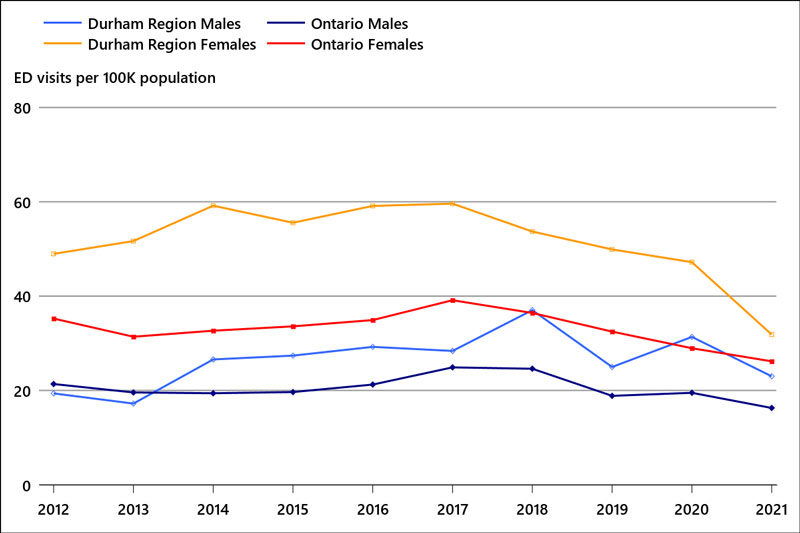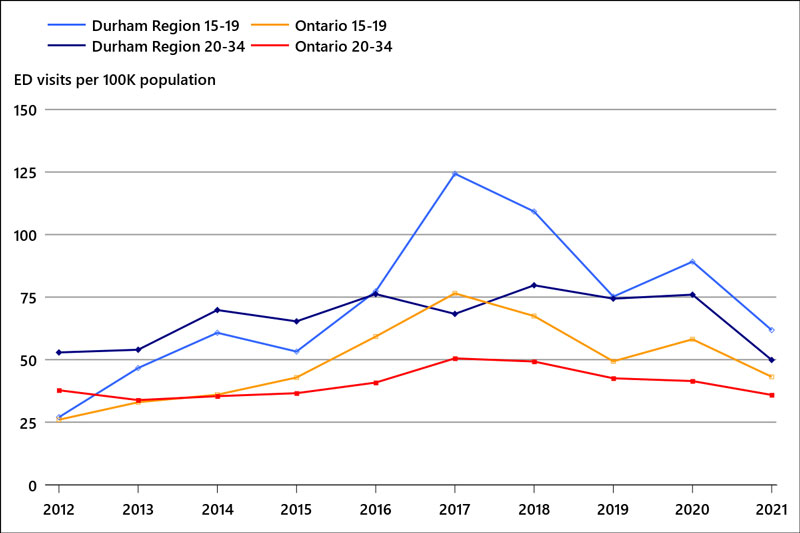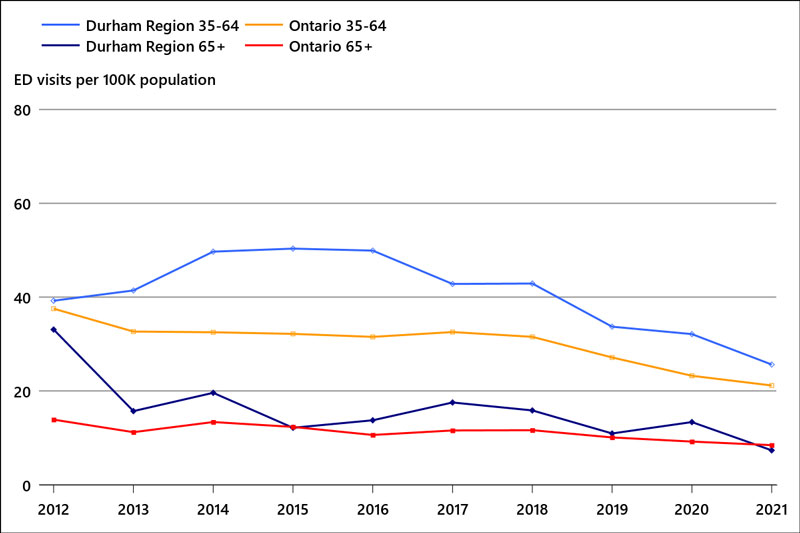
Benzodiazepine Overdose Emergency Department Visits at a Glance
Release date: March 2023
Highlights
- This report examines trends in emergency department (ED) visits for benzodiazepine (pronounced: ben·zo·di·as·e·peen) overdose in Durham Region residents by age and sex with comparisons to Ontario.
- These drugs belong to the tranquilizer family of drugs. Ativan, Valium and Xanax are common brand names of benzodiazepine drugs. They are also known by the street names benzos, downers, nerve pills, tranks or zanies.
- Between 2012 and 2021, the rate of ED visits decreased by 35 per cent for Durham Region females and increased by 19 per cent in males. In comparison, the rates decreased in Ontario by 26 per cent in females and 24 per cent in males.
- Durham Region females were involved in almost three out of five ED visits for benzodiazepine overdose in 2021 (59 per cent; 114 of 194).
- The ED visit rate for Durham Region youth aged 15 to 19 doubled in the last 10 years. Youth had the highest ED visit rate for benzodiazepine overdose in 2021 and the highest rate of increase. However, in the last 5 years, the rate of ED visits decreased by 50 per cent for Durham Region youth.
- The ED visit rate for adults aged 20 to 34 has remained stable in the last 10 years, decreasing by 6 per cent in Durham Region similar to a 5 per cent decrease in Ontario.
- The ED visit rate for adults aged 35 to 64 decreased by 35 per cent between 2012 and 2021 and the rate for adults 65 and older decreased by 79 per cent in Durham Region.
- Durham Region rates were higher than Ontario rates for both males and females and for all examined age groups except for adults 65 and older.
Figure 1: Age-standardized ED visit rates for benzodiazepine overdose per 100,000 in Durham Region and Ontario, by sex, between 2012 and 2021

| Data table for figure 1 | |||||||||||||||||||||||||||||||||||||||||||||||||||||||||||||||||||||||||||||||||||||||||||||||||||
|
Figure 2: Age-specific ED visit rates for benzodiazepine overdose per 100,000 in Durham Region and Ontario between 2012 and 2021, ages 15 to 19 and 20 to 34 years

| Data table for figure 2 | |||||||||||||||||||||||||||||||||||||||||||||||||||||||||||||||||||||||||||||||||||||||||||||||||||
|
Figure 3: Age-specific ED visit rates for benzodiazepine overdose per 100,000 in Durham Region and Ontario between 2012 and 2021, ages 35 to 64 and 65 years and older

| Data table for figure 3 | |||||||||||||||||||||||||||||||||||||||||||||||||||||||||||||||||||||||||||||||||||||||||||||||||||
|
Data sources
ED visit data are collected by the Canadian Institute for Health Information (CIHI) on a fiscal year basis. For ED visits, the main diagnostic code is the “main problem” (MP) that is deemed to be the clinically significant reason for the visit. ED visit data provide only a crude measure of the burden of drug use. Data are influenced by factors that are unrelated to health status such as availability and accessibility of care, administrative policies and hospital procedures. This may influence comparisons between areas and over time. In particular, interpret 2020 and 2021 data with caution due to changes in the availability of health care and health-seeking behaviour during the COVID-19 pandemic.
For all indicators, data were analyzed by the residence of the patient, not where the ED visit occurred. Ontario residents treated outside of the province were excluded. Data were reported by calendar year, based on year of the ED visit. This report includes ED visit indicators with relevance to public health programming.
ED visits for benzodiazepine overdose were selected using ICD-10-CA code T42.4 whether it was the MP or in combination with other health problems resulting in the visit (comorbidity). Visits where the health care provider documented uncertainty in the diagnosis (diagnosis prefix Q) and visits which resulted in a transfer to another ambulatory care facility were included in the counts. Multiple codes can exist for each ED visit. As such, a unique visit number, NACRS key, was used to count the number of visits where the above code was captured as the MP or comorbidity.
Benzodiazepine overdose can occur when prescription drugs are obtained from illegitimate sources or from a risky pattern of use (excluding under-use) such as deviating from acceptable practice or non-medical use.
Definitions
Figures and tables are provided for the following indicators:
- Age-standardized ED visit rates for benzodiazepine overdose by sex
- Age-specific ED visits rates for benzodiazepine overdose in individuals aged 15 to 19, 20 to 34, 35 to 64, and 65 years and older.
Age-standardized ED visit rate
The number of ED visits per 100,000 that would occur if the population had the same age distribution as the 2011 Canadian population. This rate provides a single summary number that allows populations with different age compositions to be compared.
Age-specific ED visit rate
The total number of ED visits in a specified age group per 100,000 population in that age group. The numerator and denominator refer to the same age group.
For more information
Contact Us




